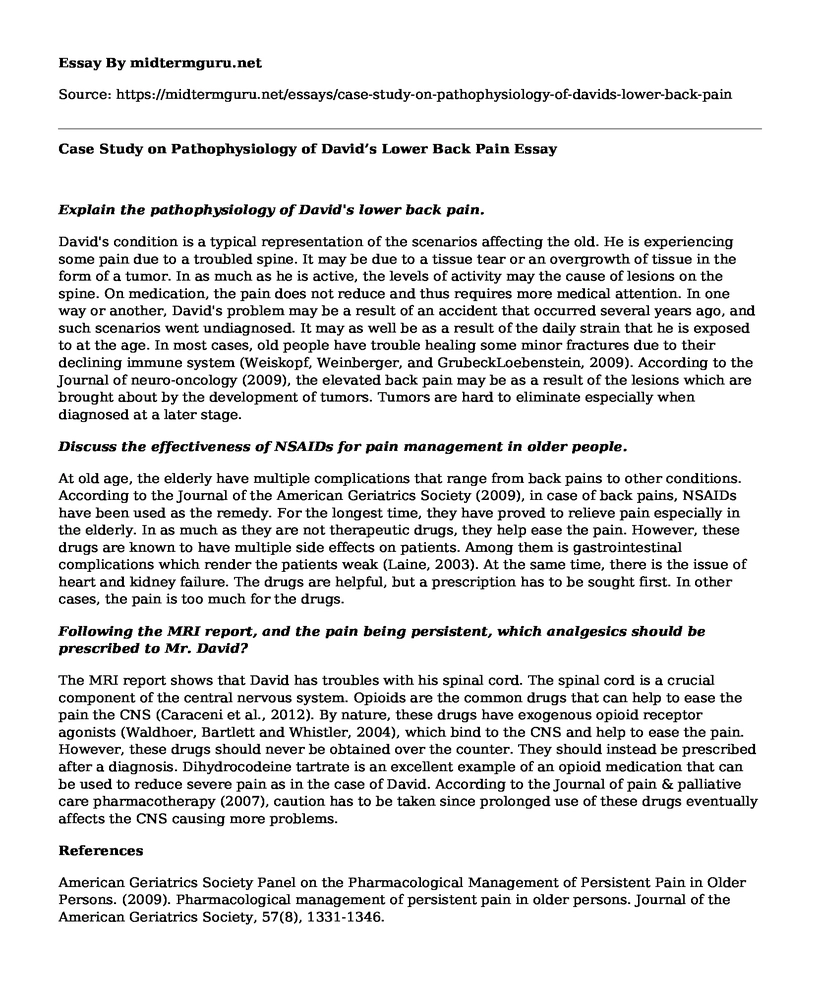Explain the pathophysiology of David's lower back pain.
David's condition is a typical representation of the scenarios affecting the old. He is experiencing some pain due to a troubled spine. It may be due to a tissue tear or an overgrowth of tissue in the form of a tumor. In as much as he is active, the levels of activity may the cause of lesions on the spine. On medication, the pain does not reduce and thus requires more medical attention. In one way or another, David's problem may be a result of an accident that occurred several years ago, and such scenarios went undiagnosed. It may as well be as a result of the daily strain that he is exposed to at the age. In most cases, old people have trouble healing some minor fractures due to their declining immune system (Weiskopf, Weinberger, and GrubeckLoebenstein, 2009). According to the Journal of neuro-oncology (2009), the elevated back pain may be as a result of the lesions which are brought about by the development of tumors. Tumors are hard to eliminate especially when diagnosed at a later stage.
Discuss the effectiveness of NSAIDs for pain management in older people.
At old age, the elderly have multiple complications that range from back pains to other conditions. According to the Journal of the American Geriatrics Society (2009), in case of back pains, NSAIDs have been used as the remedy. For the longest time, they have proved to relieve pain especially in the elderly. In as much as they are not therapeutic drugs, they help ease the pain. However, these drugs are known to have multiple side effects on patients. Among them is gastrointestinal complications which render the patients weak (Laine, 2003). At the same time, there is the issue of heart and kidney failure. The drugs are helpful, but a prescription has to be sought first. In other cases, the pain is too much for the drugs.
Following the MRI report, and the pain being persistent, which analgesics should be prescribed to Mr. David?
The MRI report shows that David has troubles with his spinal cord. The spinal cord is a crucial component of the central nervous system. Opioids are the common drugs that can help to ease the pain the CNS (Caraceni et al., 2012). By nature, these drugs have exogenous opioid receptor agonists (Waldhoer, Bartlett and Whistler, 2004), which bind to the CNS and help to ease the pain. However, these drugs should never be obtained over the counter. They should instead be prescribed after a diagnosis. Dihydrocodeine tartrate is an excellent example of an opioid medication that can be used to reduce severe pain as in the case of David. According to the Journal of pain & palliative care pharmacotherapy (2007), caution has to be taken since prolonged use of these drugs eventually affects the CNS causing more problems.
References
American Geriatrics Society Panel on the Pharmacological Management of Persistent Pain in Older Persons. (2009). Pharmacological management of persistent pain in older persons. Journal of the American Geriatrics Society, 57(8), 1331-1346.
Caraceni, A., Hanks, G., Kaasa, S., Bennett, M. I., Brunelli, C., Cherny, N., ... & Haugen, D. F. (2012). Use of opioid analgesics in the treatment of cancer pain: evidence-based recommendations from the EAPC. The lancet oncology, 13(2), e58-e68.Retrieved from https://www.thelancet.com/oncology
Laine, L. (2003). Gastrointestinal effects of NSAIDs and coxibs. Journal of Pain and Symptom Management, 25(2), 32-40.Retrieved from https://www.jpsmjournal.com/article/S0885-3924(02)00629-2/fulltext
Schellinger, K. A., Propp, J. M., Villano, J. L., & McCarthy, B. J. (2008). Descriptive epidemiology of primary spinal cord tumors. Journal of neuro-oncology, 87(2), 173-179.
Vella-Brincat, J., & Macleod, A. D. (2007). Adverse effects of opioids on the central nervous systems of palliative care patients. Journal of pain & palliative care pharmacotherapy, 21(1), 15-25.
Waldhoer, M., Bartlett, S. E., & Whistler, J. L. (2004). Opioid receptors. Annual review of biochemistry, 73(1), 953-990.
Weiskopf, D., Weinberger, B., & GrubeckLoebenstein, B. (2009). The aging of the immune system. Transplant international, 22(11), 1041-1050.
Cite this page
Case Study on Pathophysiology of David's Lower Back Pain. (2022, Dec 21). Retrieved from https://midtermguru.com/essays/case-study-on-pathophysiology-of-davids-lower-back-pain
If you are the original author of this essay and no longer wish to have it published on the midtermguru.com website, please click below to request its removal:
- Discussion Questions on the Public Health in Syria - Paper Example
- Novice to Expert: Applying Benner's Stages to My Career Paper Example
- Essay Sample on Ethical Issues on the Use of Artificial Organs on Humans
- Leadership in Nursing: Presentation
- Deep Brain Stimulation in Parkinson's Disease - Essay Sample
- Increase Breastfeeding & Improve Infant Health: Invest in Education - Essay Sample
- Effects of Culture, Sexism and Stress on Maternal Experience - Paper Example







